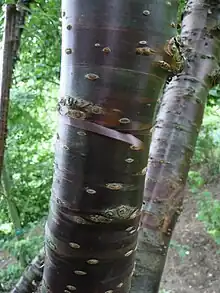| Prunus canescens | |
|---|---|
 | |
| Closeup of the bark | |
| Scientific classification | |
| Kingdom: | Plantae |
| Clade: | Tracheophytes |
| Clade: | Angiosperms |
| Clade: | Eudicots |
| Clade: | Rosids |
| Order: | Rosales |
| Family: | Rosaceae |
| Genus: | Prunus |
| Section: | P. sect. Cerasus |
| Species: | P. canescens |
| Binomial name | |
| Prunus canescens | |
| Synonyms | |
|
Cerasus canescens (Bois) S.Ya.Sokolov | |
Prunus canescens, the gray-leaf cherry (and hoary cherry, although that name is also used for Prunus incana), is a species of cherry native to China, found in Hubei and Sichuan provinces.[1] A shrubby tree, it grows to about 3 m. It is a parent of a number of hybrid rootstocks for sweet cherries, and occasionally grown as an ornamental for its attractive shiny brown bark.[2]
Hybrids
Hybrids having P. canescens as a parent include Prunus × schmittii (P. avium × P. canescens), an ornamental tree, and the important GiSeLa dwarfing rootstock series (P. cerasus × P. canescens).[3]
References
- ↑ Zhang, Qijing; Gu, Dajun (September 2016). "Genetic Relationships among 10 Prunus Rootstock Species from China, Based on Simple Sequence Repeat Markers". Journal of the American Society for Horticultural Science. 141 (5): 520–526. doi:10.21273/JASHS03827-16. Retrieved 17 July 2018.
- ↑ "Pfaf Plant Search".
- ↑ Whiting, Matthew D; Lang, Gregory; Ophardt, David (June 2005). "Rootstock and Training System Affect Sweet Cherry Growth, Yield, and Fruit Quality" (PDF). HortScience. 40 (3): 582–586. doi:10.21273/HORTSCI.40.3.582. Retrieved 17 July 2018.
External links
Wikimedia Commons has media related to Prunus canescens.
This article is issued from Wikipedia. The text is licensed under Creative Commons - Attribution - Sharealike. Additional terms may apply for the media files.
